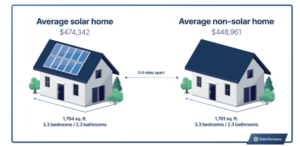Homes that have solar panels sell for 6.8% more than comparable non-solar homes
SolarReviews conducted a rigorous review of home sales within the last three years across the United States, comparing homes that have solar panels to homes that did not.
By comparing over 400 homes, SolarReviews was able to determine that a home with solar panels can sell for 6.8% higher on average. In some locations, the value added can be even higher, up to 9.2% in Michigan.
The added value of homes was apparent across the country, from homes in sunny Florida to those in rainy Seattle.

Realtors agree, with up to 34% of realtors saying that they perceive solar energy to add value to homes on the market. This study helps to prove this point.
Whether homeowners want more eco-friendly options or an energy-efficient home, solar panels can help add this value.
Here are some fast facts on solar energy:
- Enough solar energy hits the earth in one hour to power the entire planet for a year.
- Solar photovoltaic (PV) cells convert solar radiation into a usable form of energy: electricity (the term “photovoltaic” cells refers to semiconducting cells, known commonly as “solar cells”). PV power entails harnessing the sun’s energy to directly produce electricity by converting sunlight into electricity through solar cells (the “photovoltaic effect“).
- A solar panel is comprised of many solar cells, and a solar array is comprised of many solar panels.
- The basic building block of the solar cell has commonly been silicon, an element found in sand (these are known as crystalline silicon solar cells). Traditionally, solar cells are combinations of silicon and other organic materials, glass, and metal; which are manufactured to create solar PV panels.
- Different forms of the traditional silicon cell, such as amorphous silicon, and nanocrystalline silicon, are being used in flexible, thin-film solar arrays in production and use today.